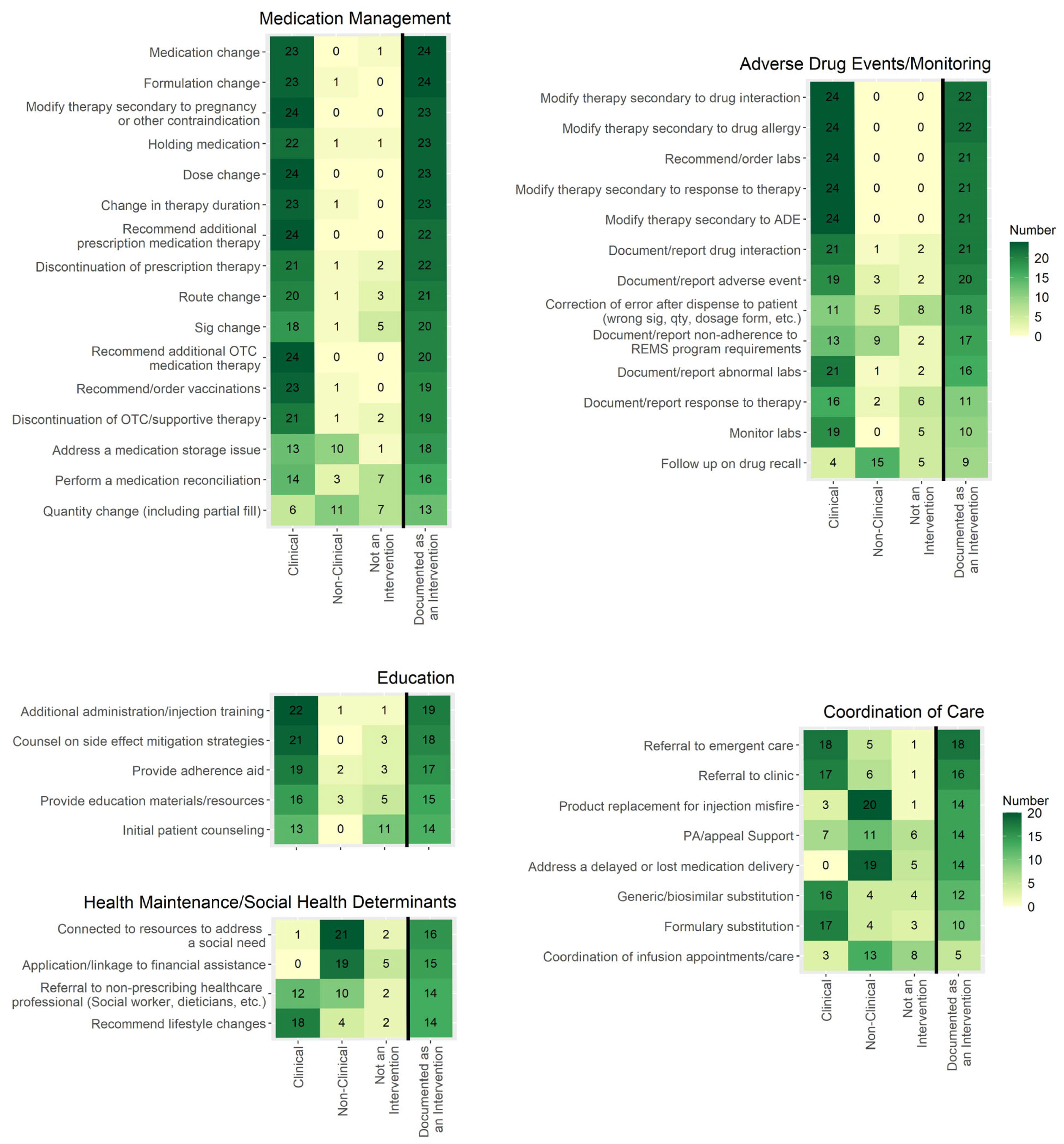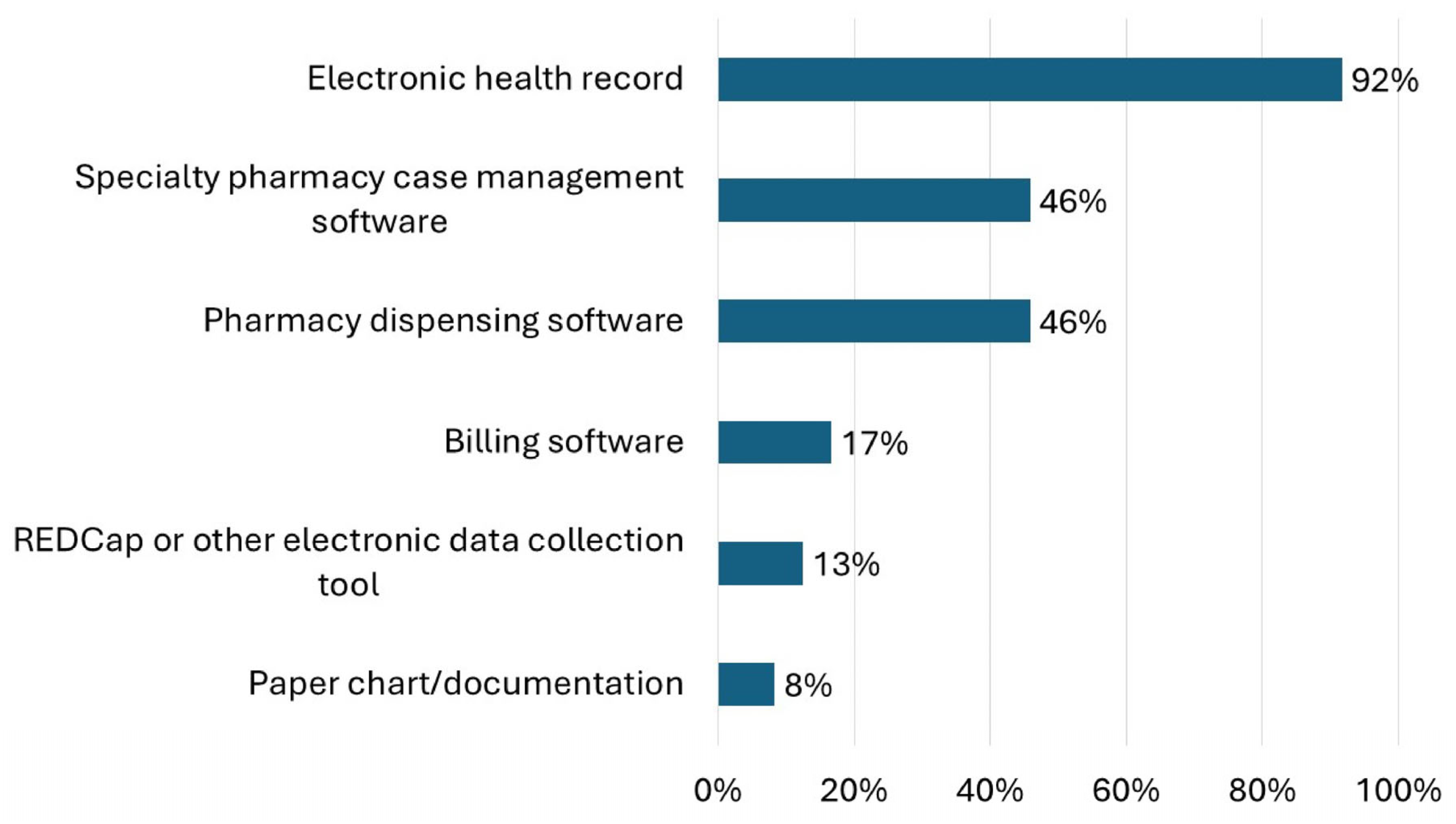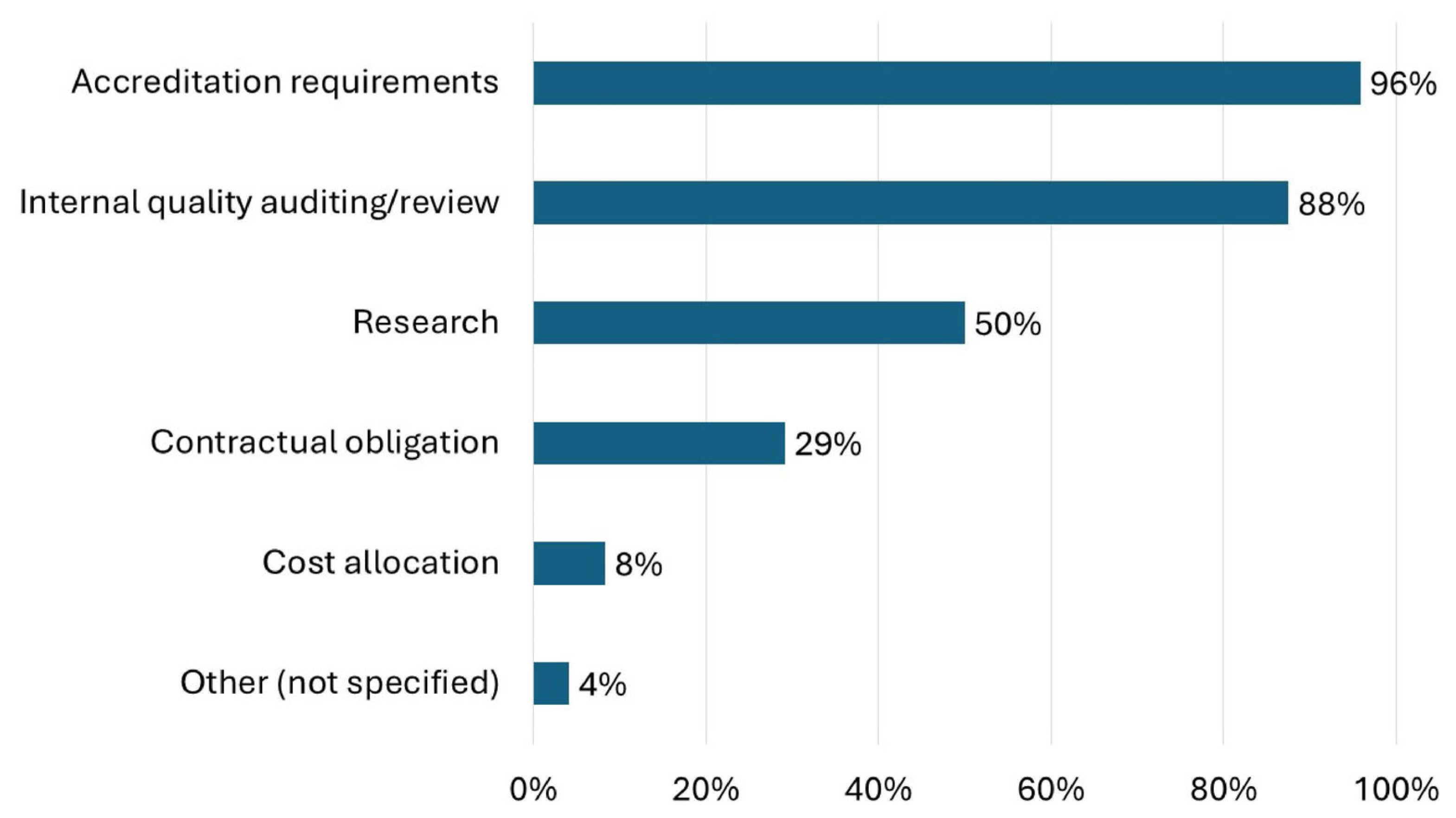Capturing Value: How Health-System Specialty Pharmacies Define and Document Pharmacist Interventions
Abstract
1. Introduction
2. Materials and Methods
3. Results
4. Discussion
4.1. Interventions Defined and Documented
4.2. Intervention Documentation
4.3. Implementation Considerations
5. Conclusions
Supplementary Materials
Author Contributions
Funding
Institutional Review Board Statement
Informed Consent Statement
Data Availability Statement
Conflicts of Interest
Abbreviations
| HSSP | Health-system specialty pharmacy |
| EHR | Electronic health record |
| ASHP | American Society of Health System Pharmacists |
| ACHC | Accreditation for Healthcare Commission |
| TJC | The Joint Commission |
| PQA | Pharmacy Quality Alliance |
| NASP | National Association of Specialty Pharmacy |
References
- De Rijdt, T.; Willems, L.; Simoens, S. Economic effects of clinical pharmacy interventions: A literature review. Am. J. Health Syst. Pharm. 2008, 65, 1161–1172. [Google Scholar] [CrossRef]
- Kaboli, P.J.; Hoth, A.B.; McClimon, B.J.; Schnipper, J.L. Clinical pharmacists and inpatient medical care: A systematic review. Arch. Intern. Med. 2006, 166, 955–964. [Google Scholar] [CrossRef]
- Ho, C.K.; Mabasa, V.H.; Leung, V.W.; Malyuk, D.L.; Perrott, J.L. Assessment of clinical pharmacy interventions in the intensive care unit. Can. J. Hosp. Pharm. 2013, 66, 212–218. [Google Scholar] [CrossRef]
- Finley, P.R.; Rens, H.R.; Pont, J.T.; Gess, S.L.; Louie, C.; Bull, S.A.; Bero, L.A. Impact of a collaborative pharmacy practice model on the treatment of depression in primary care. Am. J. Health Syst. Pharm. 2002, 59, 1518–1526. [Google Scholar] [CrossRef]
- Hawksworth, G.M.; Corlett, A.J.; Wright, D.J.; Chrystyn, H. Clinical pharmacy interventions by community pharmacists during the dispensing process. Br. J. Clin. Pharmacol. 1999, 47, 695–700. [Google Scholar] [CrossRef] [PubMed]
- Lankford, C.; Dura, J.; Tran, A.; Lam, S.W.; Naelitz, B.; Willner, M.; Geyer, K. Effect of clinical pharmacist interventions on cost in an integrated health system specialty pharmacy. J. Manag. Care Spec. Pharm. 2021, 27, 379–384. [Google Scholar] [CrossRef] [PubMed]
- Yung, E.; McNicol, M.; Lewis, D.; Fischer, J.; Petkus, K.; Sebastian, S.; Abdel-Rasoul, M.; Schmuhl, K.; Wise, K. Economic impact of pharmacist interventions in pediatric ambulatory care clinics. J. Am. Pharm. Assoc. 2021, 61, 198–205.e1. [Google Scholar] [CrossRef] [PubMed]
- Georgieva, D.; Markley, B.; DeClercq, J.; Choi, L.; Zuckerman, A.D. Cost avoidance from health system specialty pharmacist interventions in patients with multiple sclerosis. J. Manag. Care Spec. Pharm. 2024, 30, 336–344. [Google Scholar] [CrossRef]
- Patanwala, A.E.; Narayan, S.W.; Haas, C.E.; Abraham, I.; Sanders, A.; Erstad, B.L. Proposed guidance on cost-avoidance studies in pharmacy practice. Am. J. Health Syst. Pharm. 2021, 78, 1559–1567. [Google Scholar] [CrossRef]
- Stubbings, J.; Pedersen, C.A.; Low, K.; Chen, D. ASHP National Survey of Health-System Specialty Pharmacy Practice—2020. Am. J. Health-Syst. Pharm. 2021, 78, 1765–1791. [Google Scholar] [CrossRef]
- Zuckerman, A.D.; Mourani, J.; Smith, A.; Ortega, M.; Donovan, J.L.; Gazda, N.P.; Tong, K.; Simonson, D.; Kelley, T.; DeClercq, J.; et al. 2022 ASHP Survey of Health-System Specialty Pharmacy Practice: Clinical Services. Am. J. Health Syst. Pharm. 2023, 80, 827–841. [Google Scholar] [CrossRef] [PubMed]
- Zuckerman, A.D.; Whelchel, K.; Kozlicki, M.; Simonyan, A.R.; Donovan, J.L.; Gazda, N.P.; Mourani, J.; Smith, A.M.; Young, L.; Ortega, M.; et al. Health-system specialty pharmacy role and outcomes: A review of current literature. Am. J. Health Syst. Pharm. 2022, 79, 1906–1918. [Google Scholar] [CrossRef] [PubMed]
- Kelley, T.N.; Canfield, S.; Diamantides, E.; Ryther, A.M.K.; Pedersen, C.A.; Pierce, G. ASHP Survey of Health-System Specialty Pharmacy Practice: Practice Models, Operations, and Workforce-2022. Am. J. Health Syst. Pharm. 2023, 80, 1796–1821. [Google Scholar] [CrossRef] [PubMed]
- Bonome, H.; Donovan, J. Pharmacy Hot Take: Tracking Your Clinical Intervention Outcomes; URAC: Washington, DC, USA, 2023; Available online: https://www.urac.org/wp-content/uploads/2023/06/Tracking-Clinical-Interventions-Webinar-Slides.pdf (accessed on 7 December 2023).
- Sasnovskaya, V.; Kumor, L.M.; Stubbings, J.; Chevalier, A. A pharmacist-managed virtual consult service to improve tuberculosis screening. Am. J. Health Syst. Pharm. 2021, 79, e41–e49. [Google Scholar] [CrossRef]
- Farano, J.L.; Kandah, H.M. Targeting Financial Toxicity in Oncology Specialty Pharmacy at a Large Tertiary Academic Medical Center. J. Manag. Care Spec. Pharm. 2019, 25, 765–769. [Google Scholar] [CrossRef]
- Goldsberry, W.N.; Summerlin, S.S.; Guyton, A.; Caddell, B.; Huh, W.K.; Kim, K.H.; Liang, M.I. The financial burden of PARP inhibitors on patients, payors, and financial assistance programs: Who bears the cost? Gynecol. Oncol. 2021, 160, 800–804. [Google Scholar] [CrossRef]
- Shah, N.B.; Mitchell, R.E.; Proctor, S.T.; Choi, L.; DeClercq, J.; Jolly, J.A.; Hemnes, A.R.; Zuckerman, A.D. High rates of medication adherence in patients with pulmonary arterial hypertension: An integrated specialty pharmacy approach. PLoS ONE 2019, 14, e0217798. [Google Scholar] [CrossRef]
- Wright, B.A.; Singh, S.B.; Schultz, J.L.; Ramsey, L.J.; Spading, K.A.; Mascardo, L.A.; Starner, T.D. Impact of pharmacy services on cystic fibrosis transmembrane conductance regulator modulator prescribing at a pediatric cystic fibrosis center. Pediatr. Pulmonol. 2019, 54, 1591–1595. [Google Scholar] [CrossRef]
- Zullig, L.L.; Wolf, S.; Vlastelica, L.; Shankaran, V.; Zafar, S.Y. The Role of Patient Financial Assistance Programs in Reducing Costs for Cancer Patients. J. Manag. Care Spec. Pharm. 2017, 23, 407–411. [Google Scholar] [CrossRef]
- Roder, L.; Simonsen, M.; Fitzpatrick, L.; He, J.; Loucks, J. Impact of pharmacy services on time to elexacaftor-tezacaftor-ivacaftor initiation. J. Manag. Care Spec. Pharm. 2022, 28, 989–996. [Google Scholar] [CrossRef]
- Patrawala, S.; Mustafa, S.S.; Ramsey, A. Role of an embedded health system specialty pharmacy on prescription of biologics in allergy/immunology. Ann. Allergy Asthma Immunol. 2024, 133, 602–603. [Google Scholar] [CrossRef] [PubMed]
- Wyatt, H.; Peter, M.; DeClercq, J. Assessing the impact of limited distribution drug networks on time to access oral oncolytic agents at an integrated specialty pharmacy. J. Hematol. Oncol. Pharm. 2020, 10, 198–205. [Google Scholar]
- Bagwell, A.; Kelley, T.; Carver, A.; Lee, J.B.; Newman, B. Advancing Patient Care Through Specialty Pharmacy Services in an Academic Health System. J. Manag. Care Spec. Pharm. 2017, 23, 815–820. [Google Scholar] [CrossRef]
- Reynolds, V.W.; Chinn, M.E.; Jolly, J.A.; Kelley, T.N.; Peter, M.E.; Choi, L.; Nwosu, S.; Leon, B.C.; Zuckerman, A.D. Integrated specialty pharmacy yields high PCSK9 inhibitor access and initiation rates. J. Clin. Lipidol. 2019, 13, 254–264. [Google Scholar] [CrossRef]
- Whetstone, M.; Reichard, J.; Sigmon, S. Impact of specialty pharmacy taking ownership of the prior authorization process of multiple sclerosis specialty medications to increase access to infusible disease-modifying therapy (DMT). J. Drug Assess. 2019, 8 (Suppl. 1), 26. [Google Scholar] [CrossRef]
- Burrus, T.E.; Vogt, H.; Pettit, R.S. Impact of a Pharmacy Technician and Pharmacist on Time to Inhaled Tobramycin Therapy in a Pediatric Cystic Fibrosis Clinic. Pediatr. Pulmonol. 2021, 56, 2861–2867. [Google Scholar] [CrossRef]
- Choi, D.K.; Cohen, N.A.; Choden, T.; Cohen, R.D.; Rubin, D.T. Delays in Therapy Associated With Current Prior Authorization Process for the Treatment of Inflammatory Bowel Disease. Inflamm. Bowel Dis. 2023, 29, 1658–1661. [Google Scholar] [CrossRef]
- Choi, D.K.; Rubin, D.T.; Puangampai, A.; Lach, M. Role and Impact of a Clinical Pharmacy Team at an Inflammatory Bowel Disease Center. Crohns Colitis 360 2023, 5, otad018. [Google Scholar] [CrossRef]
- Zuckerman, A.D.; Carver, A.; Cooper, K.; Markley, B.; Mitchell, A.; Reynolds, V.W.; Saknini, M.; Wyatt, H.; Kelley, T. An Integrated Health-System Specialty Pharmacy Model for Coordinating Transitions of Care: Specialty Medication Challenges and Specialty Pharmacist Opportunities. Pharmacy 2019, 7, 163. [Google Scholar] [CrossRef]
- Fann, J.; Kozlicki, M.; Whelchel, K. Implementing a Letter Template to Expedite Specialty Medication Appeal Letter Submission. J. Am. Pharm. Assoc. 2024, 65, 102262. [Google Scholar] [CrossRef]
- Dale, J.R.; Murray, R.L.; Levet, C.M.; Babin, S.F. Beyond the call: Implementing a patient-first digital refill solution in a health-system specialty pharmacy. Am. J. Health Syst. Pharm. 2025, zxaf192. [Google Scholar] [CrossRef]
- Starr, M. Specialty Pharmacy Interventions Framework. Online; In NASP’s 5-Step Procedure Tracks Patient Intervention Effectiveness; Specialty Pharmacy Continuum: New York, NY, USA, 2025; Available online: https://www.specialtypharmacycontinuum.com/Clinical/Article/02-25/Specialty-Pharmacy-Interventions-Framework/76219?ses=ogst (accessed on 29 October 2025).
- Pharmacy Quality Alliance. Medication Management Services; Pharmacy Quality Alliance: Alexandria, VA, USA, 2025; Available online: https://www.pqaalliance.org/medication-management-services (accessed on 29 October 2025).



| Clinical Intervention |
|
| Non-clinical intervention |
|
| Less likely to be considered an intervention |
|
| Question | Response | Number (n = 24) | Percentage |
|---|---|---|---|
| Who can perform clinical interventions at your organization? | Pharmacists | 24 | 100.0% |
| Interns | 9 | 37.5% | |
| Technicians | 3 | 12.5% | |
| Who can perform non-clinical interventions at your organization? | Pharmacists | 24 | 100.0% |
| Technicians | 23 | 95.8% | |
| Interns | 18 | 75.0% | |
| Other (enrollment coordinators, financial counselors, office coordinator, nurses, students) | 6 | 25.0% | |
| How are interventions documented in the electronic health record? | Specialty pharmacy-specific note/encounter documentation | 19 | 79.2% |
| Reportable issue tracking functionality (e.g., iVent/MTP) | 10 | 41.7% | |
| Message to provider | 9 | 37.5% | |
| General note/encounter documentation | 8 | 33.3% | |
| Association with the medication record | 4 | 16.7% | |
| Other (Epic Flowsheets and Specialty Navigator, Excel Document) | 1 | 4.2% | |
| Indicate if these elements are included in your organization’s intervention documentation | Cost/financial outcome if intervention was not performed | 4 | 16.7% |
| Time spent performing the intervention | 14 | 58.3% | |
| Potential adverse event had intervention not been performed | 10 | 41.7% | |
| Probability of adverse event happening if intervention had not been performed | 2 | 8.3% | |
| Would the intervention have been made regardless of pharmacist involvement | 0 | 0.0% |
| Question | Response | Number (n = 24) | Percentage |
|---|---|---|---|
| How often does your organization review intervention data? | Quarterly | 18 | 75.0% |
| Monthly | 7 | 29.2% | |
| As needed | 7 | 29.2% | |
| Daily | 3 | 12.5% | |
| Yearly | 3 | 12.5% | |
| Unscheduled | 1 | 4.2% | |
| Weekly | 0 | 0.0% | |
| Which internal stakeholders receive reports of intervention data? | Coordinators/Managers | 22 | 91.7% |
| Staff | 18 | 75.0% | |
| Administrators | 16 | 66.7% | |
| None | 0 | 0.0% | |
| Does your organization report data to external stakeholders? | No | 14 | 58.3% |
| Yes | 10 | 41.7% | |
| Which external stakeholders receive reports of intervention data? (n = 10) | Accrediting bodies | 9 | 90.0% |
| Clinic providers | 7 | 70.0% | |
| Payors | 7 | 70.0% | |
| Hospital/health-system administration | 6 | 60.0% | |
| Other (manufacturers, REMS programs) | 1 | 10.0% | |
| Patients | 0 | 0.0% | |
| How does your organization categorize intervention data in reporting? | Type of intervention | 21 | 87.5% |
| Medication | 12 | 50.0% | |
| Diagnosis or therapeutic group | 10 | 41.7% | |
| Team/individual performing the intervention | 6 | 25.0% | |
| Medication type (i.e., specialty vs. specialty-lite) | 5 | 20.8% | |
| Adverse outcome avoided by from intervention | 2 | 8.3% | |
| Does your organization quantify the clinical or financial value of interventions? | No | 20 | 83.3 |
| Yes | 4 | 16.7% |
Disclaimer/Publisher’s Note: The statements, opinions and data contained in all publications are solely those of the individual author(s) and contributor(s) and not of MDPI and/or the editor(s). MDPI and/or the editor(s) disclaim responsibility for any injury to people or property resulting from any ideas, methods, instructions or products referred to in the content. |
© 2025 by the authors. Licensee MDPI, Basel, Switzerland. This article is an open access article distributed under the terms and conditions of the Creative Commons Attribution (CC BY) license (https://creativecommons.org/licenses/by/4.0/).
Share and Cite
Zuckerman, A.D.; Thomas, K.C.; Diamantides, E.; Takhar, S.; Shah, R.; Conant, K.; Platt, T.; Rhudy, C. Capturing Value: How Health-System Specialty Pharmacies Define and Document Pharmacist Interventions. Pharmacy 2025, 13, 172. https://doi.org/10.3390/pharmacy13060172
Zuckerman AD, Thomas KC, Diamantides E, Takhar S, Shah R, Conant K, Platt T, Rhudy C. Capturing Value: How Health-System Specialty Pharmacies Define and Document Pharmacist Interventions. Pharmacy. 2025; 13(6):172. https://doi.org/10.3390/pharmacy13060172
Chicago/Turabian StyleZuckerman, Autumn D., Karen C. Thomas, Erica Diamantides, Shannan Takhar, Rushabh Shah, Kelsi Conant, Thom Platt, and Christian Rhudy. 2025. "Capturing Value: How Health-System Specialty Pharmacies Define and Document Pharmacist Interventions" Pharmacy 13, no. 6: 172. https://doi.org/10.3390/pharmacy13060172
APA StyleZuckerman, A. D., Thomas, K. C., Diamantides, E., Takhar, S., Shah, R., Conant, K., Platt, T., & Rhudy, C. (2025). Capturing Value: How Health-System Specialty Pharmacies Define and Document Pharmacist Interventions. Pharmacy, 13(6), 172. https://doi.org/10.3390/pharmacy13060172






